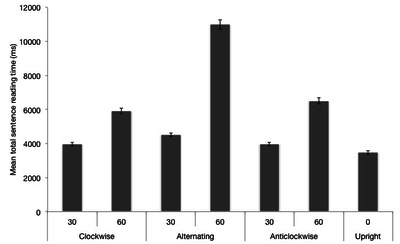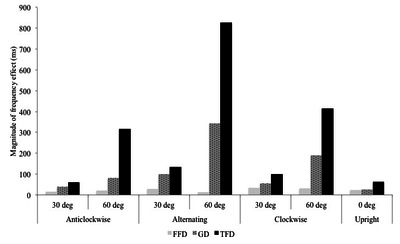Blythe, Hazel I., Juhasz, Barbara J., Tbaily, Lee W., Rayner, Keith and Liversedge, Simon Paul  ORCID: 0000-0002-8579-8546
(2019)
Reading sentences of words wtih rotated letters: An eye movement study.
Quarterly Journal of Experimental Psychology, 72
(7).
pp. 1790-1804.
ISSN 1747-0218
ORCID: 0000-0002-8579-8546
(2019)
Reading sentences of words wtih rotated letters: An eye movement study.
Quarterly Journal of Experimental Psychology, 72
(7).
pp. 1790-1804.
ISSN 1747-0218
Preview |
PDF (Author Accepted Manuscript)
- Accepted Version
Available under License Creative Commons Attribution Non-commercial No Derivatives. 689kB |
Preview |
PDF (Supplementary Information)
- Supplemental Material
Available under License Creative Commons Attribution Non-commercial No Derivatives. 10kB |
Preview |
Image (TIFF) (Figure 1)
- Cover Image
Available under License Creative Commons Attribution Non-commercial No Derivatives. 67kB |
![Figure 2 [thumbnail of Figure 2]](https://clok.uclan.ac.uk/24458/4.hassmallThumbnailVersion/24458%20Figure_2.jpg)  Preview |
Image (JPEG) (Figure 2)
- Cover Image
Available under License Creative Commons Attribution Non-commercial No Derivatives. 30kB |
![Figure 3 [thumbnail of Figure 3]](https://clok.uclan.ac.uk/24458/5.hassmallThumbnailVersion/24458%20Figure3.jpg)  Preview |
Image (JPEG) (Figure 3)
- Cover Image
Available under License Creative Commons Attribution Non-commercial No Derivatives. 34kB |
Official URL: https://doi.org/10.1177/1747021818810381
Abstract
Participants’ eye movements were measured as they read sentences in which individual letters within words were rotated. Both the consistency of direction and the magnitude of rotation were manipulated (letters rotated all in the same direction, or alternately clockwise and anti-clockwise; by 30 or 60 degrees). Each sentence included a target word that was manipulated for frequency of occurrence. Our objectives were threefold: To quantify how change in the visual presentation of individual letters disrupted word identification, and whether disruption was consistent with systematic change in visual presentation; to determine whether inconsistent letter transformation caused more disruption than consistent letter transformation; to determine whether such effects were comparable for words that were high and low frequency to explore the extent to which they were visually or linguistically mediated. We found that disruption to reading was greater as the magnitude of letter rotation increased, although even small rotations impacted processing. The data also showed that alternating letter rotations were significantly more disruptive than consistent rotations; this result is consistent with models of lexical identification in which encoding occurs over units of more than one adjacent letter. These rotation manipulations also showed significant interactions with word frequency on the target word: gaze durations and total fixation duration times increased disproportionately for low frequency words when they were presented at more extreme rotations. These data provide a first step towards quantifying the relative contribution of the spatial relationships between individual letters to word recognition and eye movement control in reading.
Repository Staff Only: item control page

 Tools
Tools Tools
Tools https://orcid.org/0000-0002-8579-8546
https://orcid.org/0000-0002-8579-8546
